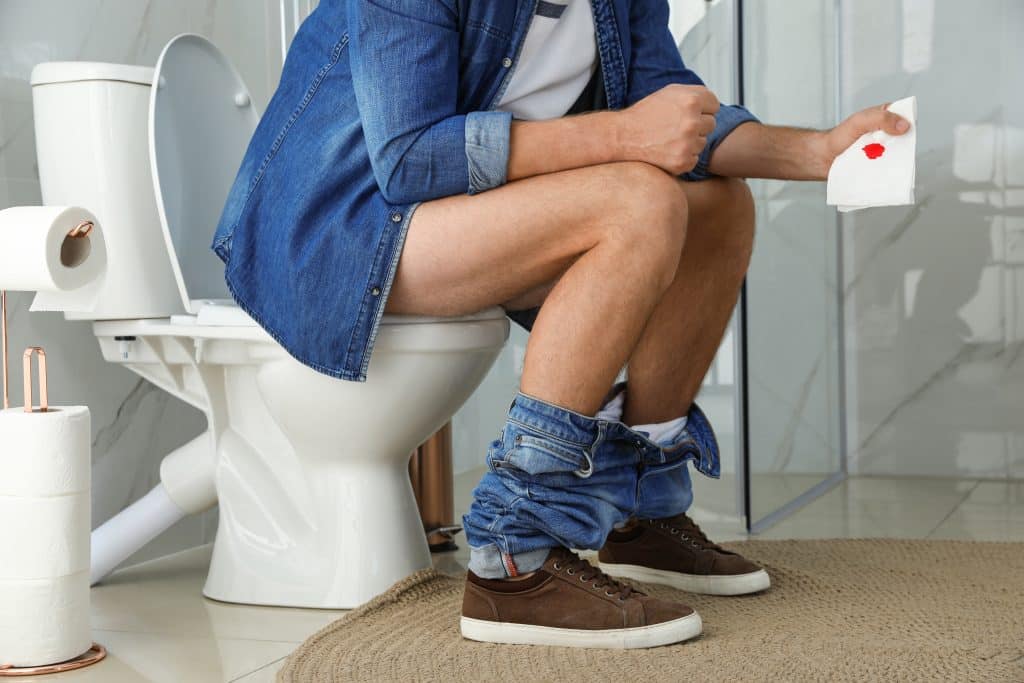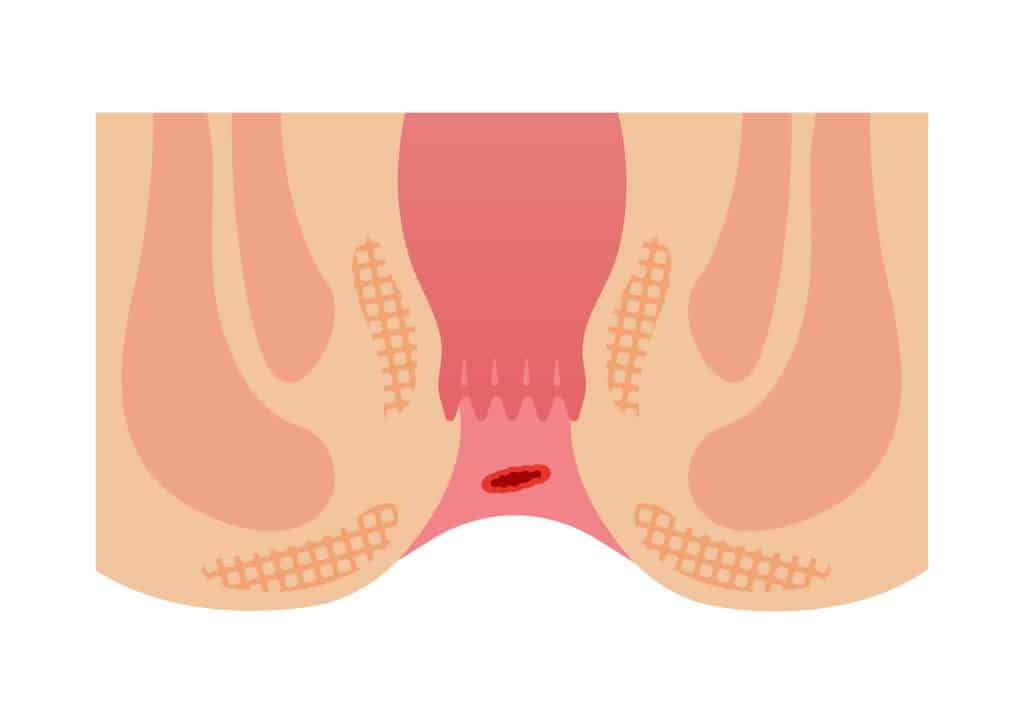It is not uncommon to see splotches of bright red blood in the bowl or blood on toilet paper after pooping. Some of my patients share with me that the blood can drip or even stream into the bowl. At times the bleeding happens without a bowel movement and the blood soaks the underwear or pants. Yes this is scary to most, but don’t panic, the information below will help shed light on why we see blood. There is a big difference between bright red rectal bleeding vs. hemorrhage or severe bleeding.
There are a number of reasons why people have bright red blood with or after a bowel movement. Most of the causes are minor, while other reasons may be more serious such as a large rectal polyp, colitis, anal, rectal or colon cancer.
Pay attention to the color of the blood and the quantity of the blood which can help to indicate the cause of the problem. Below are some of the more common reasons why you are seeing blood on the toilet paper or in the bowl during or after a bowel movement and when to be concerned about them.
- Bright red blood suggests bleeding in the rectum or anus.
- Dark red blood or maroon colored blood mixed in the stool is usually a sign of bleeding in the upper colon and is suspicious for cancer.
- Copious amounts of maroon colored stool or bloody diarrhea typically indicate a massive bleed from the colon usually due to diverticulosis (pouches of the colon) or Ulcerative Colitis.
- Black tarry stool indicates bleeding in the stomach or small intestine. It can also be a sign of proximal colon cancer. Blood from the upper GI tract gets digested and turns black.
- Bright red blood which drips or streams into the bowl or bright red blood on the toilet paper after a bowel movement is primarily due to hemorrhoids.
- Bright red blood streaking the stool. This is usually a sign of internal hemorrhoid bleeding, however; large polyps or even cancer of the lowest portion of the rectum can bleed which will streak the stool with blood.
Possible Causes of Anal Bleeding

Beyond just seeing bright red blood some patients may have other associated symptoms. Deep rectal aching or pain, change in stool consistency to liquid stool are associated with rectal cancer. A sharp pain with a bowel movement followed by bleeding is a sign of an anal fissure.
Regardless of the bleeding, due to the greatly increased risk of colorectal cancer in younger patients, I strongly recommend an appointment with a specialist in proctology, like myself, for an evaluation.
It is recommended that all patients with rectal bleeding require a colonoscopy to evaluate the whole colon even if the bleeding stops. Cancer may not be the cause, however; a colonoscopy will find and remove polyps which if left untreated will grow into cancer. This is how younger patients like Chadwick Bosemen, the actor, developed and died of colon cancer at the age of 39. He was diagnosed at age 35.
Every young patient I saw with colon cancer requiring a colon resection told me he/she had rectal bleeding 5 years earlier and never had a colonoscopy. Had a colonoscopy been performed a polyp would have been found, removed, and colon cancer would have been prevented.
New data shows colon and rectal cancer rates are rising rapidly in patients younger than 40 years of age. Information from an article in Practical Gastroenterology states that colon cancer in younger patients is primarily toward the end of the colon or rectum which can cause rectal bleeding. The cancers are more aggressive and the delay in diagnosis is 4 times longer than patients 50 years of age or older. The delay in diagnosis was due to invalidating symptoms like bleeding or constipation and blaming the symptoms on hemorrhoids.
Reasons why all patients younger than 45 with bleeding require a colonoscopy include; the increased risk of colorectal cancer, the more aggressive nature of colon or rectal cancer in younger patients and the 4 times delay in diagnosis for younger patients with colorectal cancer. This is what I recommend to all my younger patients with symptoms of bleeding.
Hemorrhoids

Hemorrhoids are veins which reside inside and outside of the anus. They are organs just like lungs, heart, kidneys and spleen are organs. Hemorrhoids are venous cushions which have a blood supply (artery which pumps blood into the hemorrhoid) and a venous return (veins which return the blood to the body). They are a part of our anatomy just like our eyes, nose, ears, toes, etc. We are born with at least 6 hemorrhoids, three within the anus (internal hemorrhoids) and three outside the anal opening (external hemorrhoids).
External hemorrhoid veins are abundant in nerve endings. The internal hemorrhoid veins lack pain fibers. Internal and external hemorrhoid veins are like apples and oranges. Although they are both venous cushions, their symptoms and treatment are completely different. Though we have theories as to the function of hemorrhoids, there is no real scientific evidence of their purpose. It is proposed that the function of hemorrhoids is to aid in keeping stool from leaking out of the anus.
When hemorrhoid veins become inflamed and enlarged they can become symptomatic. The blood pumped into the hemorrhoid is thin and normal, however; when the blood enters the inflamed hemorrhoid the inflammatory proteins made by the body thicken the blood so it is difficult to leave the hemorrhoid. This is called chronic venous insufficiency (CVI).
With CVI there is more blood leading into the hemorrhoid than returning to the body. Think of a water balloon on a faucet but the balloon has tubes allowing water to flow back to the system. If the of water coming into the balloon becomes thick like maple syrup, more water will enter the balloon than will leave the balloon so the balloon becomes bigger. This is what happens with inflamed hemorrhoids. As they become larger they start to cause symptoms.
Myths About Hemorrhoids
- All bumps around the anus which cause pain and bleeding are hemorrhoids.
- Laser hemorrhoidectomy hurts less than cold scalpel hemorrhoidectomy
- Hemorrhoids are hereditary (don’t forget we are all born with hemorrhoids)
- All hemorrhoids require surgery to treat the problem.
Symptoms of Hemorrhoids
Internal hemorrhoid symptoms:
- Discomfort (throbbing, aching)
- Itching
- Painless bleeding
- Anorectal pressure
- Prolapse (protrude outside of the anus)
- Urgency (feeling of having to have a bowel movement butt no stool comes out)
- Mucous discharge
- Necrosis (the hemorrhoids become trapped outside the anus and the hemorrhoid tissue starts to die). This is a surgical emergency.
The majority of internal hemorrhoid symptoms can be managed with conservative measures such as adding raw psyllium fiber, office based therapy like hemorrhoid sclerotherapy or rubber band ligation and micronized Diosmin (antioxidant which shrinks hemorrhoids and varicose veins).
Anal Fissure

A fissure is a tear of the skin at the edge of the anus. It is very similar to both a paper cut on your finger or a split lip. If you cut your finger the immediate response is to squeeze the finger with your other hand for a few minutes until the pain minimizes. You don’t continue to squeeze your finger as it would increase the pain. Another analogy is a split lip. Think about the last time you tried to bite into a sandwich that was too big. After you opened your mouth as wide as you could, the side of your lip split open. At that moment you knew you cut your lip and immediately pursed your lips and put the back of your hand to your mouth to hold pressure. When you looked at your hand you noticed a little blood. Over time you stop pursing your lips and relax your mouth. An anal fissure is exactly the same thing.
The skin around the anus splits causing a sharp or burning pain and bleeding. The blood can be seen on the toilet paper or it can drip into the bowl. Due to the increased vascularity of the anus the bleeding can be impressive but almost always stops after a few minutes.
Fissures can be acute (new) or chronic (persistent). An acute fissure has an 80% chance of healing. When a fissure lasts over 6 weeks it is considered chronic and has less than a 60% chance of healing. Chronic fissures are usually associated with a tag at the outside edge of the anus (sentinel pile) and a tag inside the anus (hypertrophied anal papillae). These tags, when seen by the examining physician are indicators that the fissure is chronic and has less of a chance of healing.
Treatment for an anal fissure is primarily conservative with raw Psyllium Fiber, special sphincter relaxing ointments, sitz baths and time. Over 90% of acute or early fissures heal with conservative measures.
Polyps
Polyps are growths on the inner lining of the colon or rectum. They can have different shapes and be raised or flat or pedunculated (on a stalk like a mushroom). They are usually pre-cancerous when they first appear and can turn cancerous if they are not removed. If a polyp becomes large enough and is low in the rectum it can cause bright red bleeding or streaks of blood on the stool.
Proctitis
Proctitis is inflammation of the rectum. We don’t know the cause but the lining of the rectum becomes inflamed. On appearance it looks like sand paper was rubbed on the lining of the rectum. This irritation causes bleeding as the stool passes over the inflamed mucosal lining. Once the diagnosis is made, treatment includes special suppositories or enemas. If left untreated the inflammation can migrate up the colon and lead to Ulcerative Colitis. Proctitis is more common in females.
When to See a Doctor About Rectal Bleeding

Although most cases of rectal bleeding aren’t a cause for immediate alarm, it is still important to see a proctologist, like myself, about any bleeding. Depending on the condition that is causing it, earlier treatment will help to avoid any complications.
When you visit your doctor, make sure to note the color of the blood, how much blood is seen, and the appearance of your stool. Be sure to tell your doctor of any other symptoms you might be experiencing such as abdominal cramping or abdominal pain, change in stool size to smaller and thinner, unexplained weight loss, or fatigue. This will help to create a starting point for diagnosis.
A proctologist will provide a thorough evaluation and diagnose the problem. When the symptoms are due to large internal hemorrhoids a proctologist can treat your internal hemorrhoids without pain which will stop the bleeding. Even if the bleeding stops, a colonoscopy is mandatory for all patients younger than 45 with bleeding and who have never had one performed. Don’t wait for cancer to happen, prevent it from happening with a colonoscopy. Don’t blow off your health, you are worth the gift of good health.
If you are experiencing blood on toilet paper after pooping, schedule an appointment with Dr. Rosenfeld today 805 230-2889 (BUTZ).

